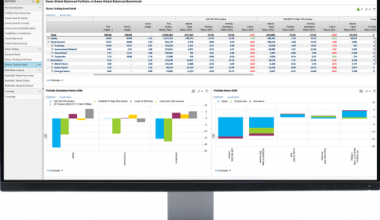Structured finance is a way of creating customized financial instruments that can meet a variety of different needs. It is a form of securitization, which involves pooling various types of contractual debt such as mortgages, auto loans, and credit card debt, and selling them in the form of bonds, notes, or other securities. Structured finance products are designed to help companies and investors meet their financial needs.
What is Structured Finance?
Structured finance is a sort of finance designed specifically for large organizations with unique or complex financial needs that exceed the usual financial products available to firms. Structured financing was designed to create a larger financial instrument to meet the financial needs of major organizations. It is more complicated than traditional corporate financial instruments such as loans. Structured finance financial instruments include collateralized bond obligations (CBOs) and collateralized debt obligations (CDOs).
Benefits of Structured Finance
Structured finance can provide many benefits to both companies and investors. For companies, structured finance can help them raise capital quickly and efficiently, enabling them to invest in growth or expand their operations. It also allows companies to manage their debt and raise funds at a lower cost than traditional financing methods.
For investors, structured finance offers several advantages. Structured products can be tailored to meet the specific needs of investors, allowing them to invest in a wide range of asset classes while minimizing risk. Additionally, structured products can provide investors with higher returns than traditional investments.
Understanding the Risks of Structured Finance
Although structured financing can provide many benefits, it also carries a certain amount of risk. Structured products are complex investments, and investors should be aware of the potential risks involved. Investors should be aware of the counterparty risk associated with structured products as well as the creditworthiness of the issuer. Additionally, investors should be aware of the potential for market changes to affect the value of their investments.
What do people in structured finance do?
People who work in structured finance are responsible for creating, managing, and monitoring structured products. They must be knowledgeable about financial markets and regulations and be adept at assessing risk. Structured financing professionals must also be familiar with the various products available and be able to create tailored solutions that meet the needs of both companies and investors.
What products are in structured finance?
Structured finance products can range from simple debt securities to complex derivatives. Common structured products include mortgage-backed securities, asset-backed securities, collateralized debt obligations, and credit default swaps. Other products include structured notes, synthetic collateralized debt obligations, and interest rate swaps.
What are the key features of structured finance?
Structured financing products are designed to meet the specific needs of both companies and investors. Structured products typically have a fixed maturity date and interest rate, as well as a predetermined repayment schedule. Additionally, structured products may include a variety of features such as prepayment options, call protection, and credit enhancements.
Overview of Structured Finance Products
Structured finance products are typically divided into two main categories: fixed income and equity. Fixed-income products include bonds, notes, and other debt instruments, while equity products include stocks, options, and derivatives. These products can also be divided into two types: primary and secondary. Primary structured products are created and issued directly by financial institutions, while secondary structured products are created and issued by investors.
Types of Structured Finance Products
Structured finance products are typically divided into two main categories: asset-backed securities (ABS) and collateralized debt obligations (CDOs). ABS are debt instruments that are secured by a pool of assets, such as mortgages or auto loans. CDOs are investment vehicles that are created by pooling a variety of debt instruments, such as corporate bonds, mortgage-backed securities, and other debt instruments.
How often do structured products pay interest?
Most structured products pay interest regularly, usually on a quarterly or annual basis. The amount and frequency of interest payments vary depending on the type of product and the issuer. For example, some structured products may pay interest monthly, while others may pay interest only once a year.
How to Invest in Structured Finance Products
Investing in structured financing products can be a complex process, and investors should be familiar with the risks and regulations associated with these products before investing. Investors should consult with a financial advisor or professional to determine the best product for their needs. Additionally, investors should be aware of the fees and costs associated with investing in these products.
Are structured products high-risk?
Structured products can be high-risk investments, as they are complex and involve a variety of risks. Investors should be aware of the potential risks associated with these products, including counterparty risk and market risk. Additionally, investors should be aware of the potential fees and costs associated with investing in structured products.
Why do investors buy structured products?
Investors buy structured products for a variety of reasons. Structured products can provide investors with higher returns than other traditional investments. Additionally, structured products can be tailored to meet the specific needs of investors, allowing them to invest in a wide range of asset classes while minimizing risk.
What is the best structure of financing?
The best structure of financing depends on the specific needs of the borrower and the lender. For most businesses, a combination of debt and equity financing is typically the best option. Debt financing allows the borrower to access capital quickly, while equity financing can provide more flexibility in terms of repayment and ownership.
How Structured Finance is Used
Structured financing is used by companies and investors to meet their financial needs. Companies use structured financing to raise capital quickly and efficiently, while investors use structured products to invest in a variety of asset classes while minimizing risk. It is also used to manage debt and to create customized financial instruments.
Is structured based on the credit policy?
Yes, structured finance products are typically based on the credit policy of the issuer. Credit policy refers to the terms and conditions of the loan, such as the interest rate, repayment schedule, and other features. The credit policy of the issuer will determine the terms and conditions of the structured product.
What is a structured finance team?
A structured finance team is a group of professionals who are responsible for creating, managing, and monitoring structured products. The team typically consists of financial analysts, risk managers, and other professionals who specialize in financial markets and regulations. The team is responsible for creating tailored solutions that meet the needs of both companies and investors.
Structured Finance Markets
Structured financing markets refer to the markets where structured products are bought and sold. These markets include the bond market, the derivatives market, and the structured products market. The markets are comprised of a variety of different investors, such as banks, hedge funds, and institutional investors.
Structured Finance Regulations
Structured finance is a heavily regulated industry, and investors should be aware of the various regulations that apply to structured products. Regulations vary by jurisdiction, and investors should consult with a financial advisor or other professional to ensure that they are compliant with applicable regulations.
What is structured finance modeling?
Structured finance modeling is the process of creating financial models to analyze and assess the risks associated with structured products. These models are used to evaluate the performance of structured products as well as the creditworthiness of the issuer. Structured finance models are typically created using financial software programs, such as Excel or MATLAB.
Structured Finance Product Examples
A range of structured financing products may be used when a regular loan is inadequate to fund particular transactions dictated by a corporation’s operational needs. Collateralized mortgage obligations (CMOs), credit default swaps (CDSs), and hybrid securities, which combine elements of debt and equity securities, are often used alongside CDOs and CBOs.
Securitization is the process of merging financial assets to produce a financial instrument, which commonly results in CDOs, asset-backed securities, and credit-linked notes. Investors are then sold various tiers of these repackaged products. Like structured financing, securitization enhances liquidity and is used to produce structured financial products utilized by qualifying companies and other clients. Securitization has numerous advantages, including being a less expensive source of funding and making better use of money.
Mortgage-backed securities (MBS) are a prime illustration of securitization and the risk-transfer utility it provides. Mortgages may be pooled into a single huge pool, allowing the issuer to divide the pool into sections based on the risk of default inherent in each mortgage. Investors may then buy the smaller pieces.
What is structured finance products?
Asset-backed securities (ABS), commercial mortgage-backed securities (CMBS), residential mortgage-backed securities (RMBS), and collateralized debt obligations are just a few examples (CDOs). These products are the result of securitization procedures that combine several products to generate an interest-bearing instrument that is offered to investors.
What is a structured financial transaction?
It entails sophisticated financial activities that allow credit risk to be transferred from the vendor to the buyer of the goods. For example, in the case of mortgage-backed securities, several products are generated from a huge pool of mortgages by dividing them into different risk classifications. The subset goods are then sold to investors, and the risk transfer occurs concurrently.
What is the structured finance analyst salary?
An analyst is one of the most common structured financing jobs. The finance analyst normally works with financial modeling to create novel investment structures and collaborates with a broad range of banking organizations. According to a Glassdoor.com survey from April 24th, 2022, the national average income for a Structured Finance Analyst in the United States is $77,343 per year.
Conclusion
Structured finance is a form of securitization that involves pooling various types of contractual debt and selling them in the form of bonds, notes, or other securities. Structured finance products can provide many benefits to both companies and investors, but they also come with a certain amount of risk. Also, structured financing products are complex investments, and investors should be aware of the potential risks and fees associated with these products before investing.
Structured financing professionals are responsible for creating, managing, and monitoring structured products, and they must be knowledgeable about financial markets and regulations. Structured finance products are typically divided into two main categories: asset-backed securities and collateralized debt obligations. Also, structured financing markets are comprised of a variety of different investors, and structured financing is a heavily regulated industry. Structured finance modeling is the process of creating financial models to analyze and assess the risks associated with structured products.
Related Articles
- GROUP DECISION MAKING: TECHNIQUES WITH EXAMPLES
- PRIVATE INVESTMENT: How To Start On The Right Foot With The Best Private investments Option
- TECHNIQUES FOR DATA MINING to Scale any Business in 2022
- Trade Finance: Overview, Definition, Course, Examples
- How To Make Your Ideas Work. Part 3






